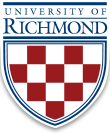The drawings of Peggy Bacon (American, 1895-1987) reveal how she used her sketches as source material for her prints. In the drawing Nymph (1931), Bacon, who usually began her process by doing a series of drawings, focused her efforts on capturing the pose of the woman (possibly a self-portrait) as she copies a painting in the museum. Using the drawing as her reference, the final drypoint print, titled Nymph, (1931), shows how she has developed the image as she draws directly on the plate with the drypoint needle-like scribing tool. With Bacon’s wonderful sense of humor, the print shows a richly toned figure intently copying Titian’s 1538 painting Venus di Urbino in a gallery of Florence’s Uffizi Gallery.
The two states of the etching The Piazetta, Venice, by Donald Shaw MacLaughlan (American, 1876-1938), demonstrate how the artist can radically change his mind as he works on the image. In the first state, printed in brown ink, a figure is placed in the extreme foreground. In the second state, printed in black ink, that figure is gone and the artist has introduced more shading to increase the sense of depth and atmosphere of the plaza. The final print is drastically modified in the process.
While the works of both Bacon and MacLaughlan in the exhibition focus on the artists’ decisions while creating a print, the lithographs of Honoré Daumier reveal that he had government censorship to consider when making his prints. After the French government passed laws censoring the press in 1835, artists and publishers alike had to modify the process of publication to avoid heavy fines and jail time. Mariez vous donc…En Chine (1844) from the series, Voyage en Chine (1843-45), shows that Daumier printed a proof of the completed narrative design. He attached the proposed wording, handwritten on a separate sheet of paper, to the proof. The second version of the print includes the text as approved by the government’s censor. Afterwards, the image and approved text were printed in the French illustrated newspaper, Le Charivari (1832-1937). The three prints are included in the exhibition.
This exhibition was organized by the University of Richmond Museums and curated by Richard Waller, Executive Director, University Museums, with Jackie Clary, ’12, art history major, University of Richmond, and 2011 Harnett Summer Research Fellow, University Museums.
2 to 4 p.m., Harnett Museum of Art
Connoisseurship: Looking at Old Master Prints
with James Goodfriend, C & J Goodfriend Drawings and Prints, New York
4 to 6 p.m., Benefit Print Sale, Harnett Print Study Center





